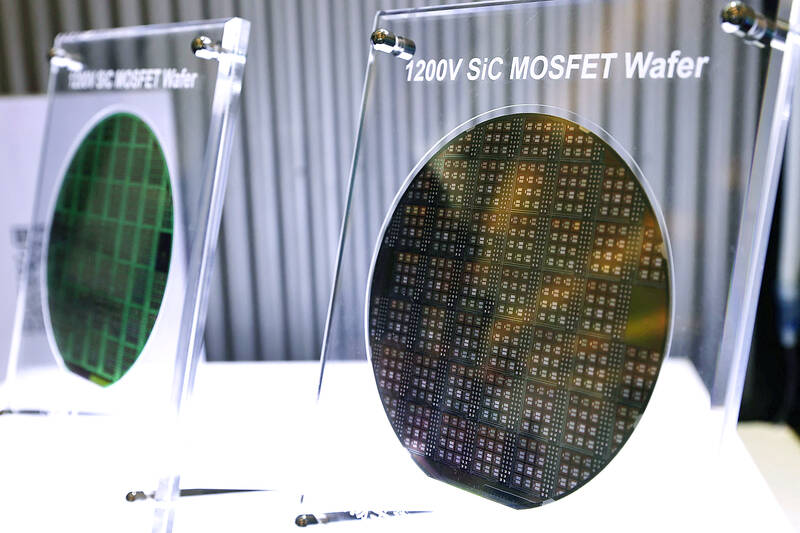Taiwan Semiconductor Manufacturing Co (TSMC, 台積電) is expected to drive growth in the global pure-play wafer foundry industry next year, Taipei-based market information advisory firm TrendForce Corp (集邦科技) said on Thursday.
The chipmaker is expected to benefit from its efforts to develop an advanced 3-nanometer process, on which it is scheduled to start mass production later this year, TrendForce senior semiconductor analyst Joanne Chiao (喬安) said at a technology forum in Taipei, adding that chips made using the process should command a higher profit margin.
Although the global pure-play wafer foundry industry has been undertaking inventory adjustments due to weakening demand, TSMC is expected to weather headwinds on the back of an increase in product prices, with the 3-nanometer process expected to make a significant contribution to its sales next year, when the firm is estimated to see its revenue rise 7 to 9 percent from this year, Chiao said.

Photo: Ann Wang, Reuters
A trial run of the 3-nanometer process began last year, while its 5-nanometer process is the latest technology for which it has launched mass production. Chips made using the technology accounted for 21 percent of TSMC’s total sales in the second quarter of this year.
An upgrade of the trialed process, dubbed 3-nanometer enhanced, is expected to first be used for commercial production next year.
On the back of TSMC’s growth, the global wafer foundry industry is expected to grow about 2.7 percent next year, moderating from an expected 28 percent increase this year, TrendForce said.
The global wafer foundry industry has been at a cyclical peak since 2020, when sales grew 24 percent from a year earlier, and year-on-year growth even hit 26.1 percent last year, Chiao said.
Demand weakness in the global wafer foundry sector has been a result of rapid inflation worldwide and China’s “zero COVID-19” policy, while US sanctions on the exportation of IC and related production equipment to China are expected to have an adverse effect on the global semiconductor industry, she said.
Although many countries are pushing for projects to build their own fabs, Taiwan’s lead over its peers in sophisticated process development should ensure its dominance in the global market for the foreseeable future, Chiao said.
However, as an increasing number of fabs are expected to start producing chips, an increase in supply is expected to present semiconductor producers with new challenges, she added.
Meanwhile, TrendForce Center for Research Operations chief operating officer Locke Chang (張小彪) said he remains cautious about the business outlook for global chip manufacturing next year.
There is no sign that inflation in the US and Europe can be brought under control in the near future, and China’s economy has been slowing amid its strict COVID-19 restrictions, which have created uncertainties in the global economy, Chang said.

The demise of the coal industry left the US’ Appalachian region in tatters, with lost jobs, spoiled water and countless kilometers of abandoned underground mines. Now entrepreneurs are eyeing the rural region with ambitious visions to rebuild its economy by converting old mines into solar power systems and data centers that could help fuel the increasing power demands of the artificial intelligence (AI) boom. One such project is underway by a non-profit team calling itself Energy DELTA (Discovery, Education, Learning and Technology Accelerator) Lab, which is looking to develop energy sources on about 26,305 hectares of old coal land in

Taiwan’s exports soared 56 percent year-on-year to an all-time high of US$64.05 billion last month, propelled by surging global demand for artificial intelligence (AI), high-performance computing and cloud service infrastructure, the Ministry of Finance said yesterday. Department of Statistics Director-General Beatrice Tsai (蔡美娜) called the figure an unexpected upside surprise, citing a wave of technology orders from overseas customers alongside the usual year-end shopping season for technology products. Growth is likely to remain strong this month, she said, projecting a 40 percent to 45 percent expansion on an annual basis. The outperformance could prompt the Directorate-General of Budget, Accounting and

Netflix on Friday faced fierce criticism over its blockbuster deal to acquire Warner Bros Discovery. The streaming giant is already viewed as a pariah in some Hollywood circles, largely due to its reluctance to release content in theaters and its disruption of traditional industry practices. As Netflix emerged as the likely winning bidder for Warner Bros — the studio behind Casablanca, the Harry Potter movies and Friends — Hollywood’s elite launched an aggressive campaign against the acquisition. Titanic director James Cameron called the buyout a “disaster,” while a group of prominent producers are lobbying US Congress to oppose the deal,

Two Chinese chipmakers are attracting strong retail investor demand, buoyed by industry peer Moore Threads Technology Co’s (摩爾線程) stellar debut. The retail portion of MetaX Integrated Circuits (Shanghai) Co’s (上海沐曦) upcoming initial public offering (IPO) was 2,986 times oversubscribed on Friday, according to a filing. Meanwhile, Beijing Onmicro Electronics Co (北京昂瑞微), which makes radio frequency chips, was 2,899 times oversubscribed on Friday, its filing showed. The bids coincided with Moore Threads’ trading debut, which surged 425 percent on Friday after raising 8 billion yuan (US$1.13 billion) on bets that the company could emerge as a viable local competitor to Nvidia